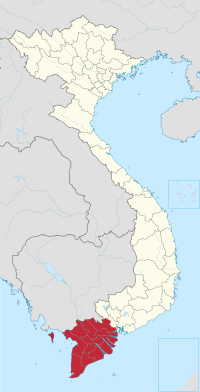|
Long Xuyên
Long Xuyên (Vietnamese: [lāwŋm sʷīən] ⓘ), formally named Thủ Đông Xuyên, is the capital city of An Giang province, in the Mekong Delta region of south-western Vietnam. History In 1789, a group of explorers established a small outpost in the Tam Khe canal, naming it Dong Xuyen. Soon after, a marketplace was created and named Long Xuyên, but by the 1860s the area became better known for the Long Xuyen market than by the official outpost's name. From 1877, the reach of Long Xuyên grew as the city's administration became responsible for an increasing number of neighborhoods and wards.[3] Long Xuyen would not be designated as a formal city until 1999.[4] GeographyIt is located approximately 1,950 km south of Hanoi, 189 km from Ho Chi Minh City, and 45 km from the Cambodian border. The population of Long Xuyên city is 272,365 (April 2019)[5], with an area of approximately 114.96 km2. The city is subdivided to 13 commune-level subdivisions, including the wards of: Mỹ Bình, Mỹ Long, Mỹ Xuyên, Bình Khánh, Mỹ Phước, Đông Xuyên, Mỹ Quý, Mỹ Thạnh, Mỹ Thới, Bình Đức, Mỹ Hòa and the rural communes of Mỹ Hòa Hưng and Mỹ Khánh. Economy As a major urban hub within the rural Mekong River Delta region, Long Xuyen is adjacent to major agricultural operations. With a major docking station in the middle of the city and rivers cutting throughout its landscape, the city connects the residents of the provinces of An Giang, Dong Thap, and Kien Giang province to the region's land-based infrastructure. With farms in towns surrounding the city connected by roads and canals, Long Xuyen (and its Quadrilateral Region) serves as a major conduit for producers of a number of commodities, with jasmine rice and basa fish being the two most well-known.[6] The proliferation of irrigation canals in the city has provided a major boon to the region's economy, but also poses a threat to environmental protection and community safety.[7] EducationLong Xuyên is home to An Giang University and the Long Xuyên Teacher's Training College. An Giang University is the second largest university in the Mekong Delta with over 10,000 students enrolled in 2021. There are three main high schools in Long Xuyên city: Thoại Ngọc Hầu, Bình Khánh and Long Xuyên. Thoại Ngọc Hầu high school was once known as Long Xuyên high school, with currently over 2,000 students. Thoại Ngọc Hầu is a specialized school for majors of English, Mathematics, Chemistry, Physics, Literature, and Biology. CultureAs Long Xuyen was designated as a city until 1999,[8] many of its residents have moved from surrounding rural towns. The Long Xuyen Floating Market is an aspect of the more traditional life that remains from more rural times.[9] With its close proximity to Cambodia, the city has a significant number of Khmer residents. Religion  Long Xuyên has a rich religious make-up. It is founding place of the Hòa Hảo Buddhist sect. There are also many Catholic churches and communities, with the Long Xuyen Diocese celebrating its 60th anniversary with 230,000 members in 2020.[10] It is one of few cities with a Cao Dai temple.[11] Former president Tôn Đức Thắng's birthday is celebrated in Mỹ Hòa Hưng (Tiger Island). CuisineWith its proximity to Cambodian border to the north, the coastline of the Gulf of Thailand (Pacific Ocean) to the west (of nearby Kien Giang province), and the Mekong River dissecting surrounding towns (but Hau River dissecting the city itself), the cuisine of Long Xuyen is heavily influenced by both local goods as well as products passing through. More locally, basa fish, mắm thái, and thot not coconuts are considered locally produced ingredients. Bun Ca Long Xuyen is a distinct specialty to the city that can be found by street vendors, who make a broth with snakehead fish and tamarind to eat with rice noodles and herbs.[12] SportsLong Xuyen is home to An Giang Football Club (Câu lạc bộ bóng đá An Giang) which plays in the V.League 2, the second tier of Vietnamese professional soccer. Notable residents
From left to right: Hoàng Diệu Bridge; Hai Ba Trung street; historic Long Xuyen Marketplace; and Tran Hung Dao street to the city center References
External links
|
||||||||||||||||||||||||||||||||||||||||||||||||||||||||||
Portal di Ensiklopedia Dunia












